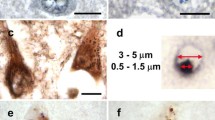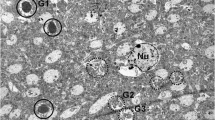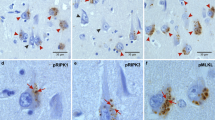Summary
Granulovacuolar degeneration (GVD) in the hippocampal pyramidal neurons of Alzheimer-type dementia was examined. Immunohistochemical examinations showed that the majority of centrally located granules were positive for ubiquitin. Based on electron microscopic observations, morphogenesis of GVD is considered to be as follows. Slight-to-moderate amounts of electron-dense material appear in the cytoplasm at the early stage, and are then surrounded and demarcated by a two-layered membrane (probably from smooth endoplasmic reticulum). Following this some inner material is digested forming floccular and liquid-like materials, while undigested material remains as coarse electron-dense granules. Specifically, granulovacuoles are considered to be an age-related special type of autophagosome. Analytical electron microscopy disclosed that the granules in GVD contained some aluminum.
Similar content being viewed by others
References
Arstila AU, Trump BF (1968) Studies on cellular autophagocytosis. The formation of autophagic vacuoles in the liver after glucagon administration. Am J Pathol 53: 687–733
Ball MJ, Lo P (1977) Granulovacuolar degeneration in aging brain and in dementia. J Neuropathol Exp Neurol 36: 474–487
Brosnan CF, Bunge MB, Murray MR (1970) The response of lysosomes in cultured neurons to chlorporomazine. J Neuropathol Exp Neurol 29: 337–353
De Duve C (1967) Lysosomes and phagosomes. Protoplasma 63: 95–98
Dickson DW, Ksiezak-Reding H, Davis P, Yen S-H (1987) A monoclonal antibody that recognizes a phosphorylated epitope in Alzheimer neurofibriallary tangles, neurofilaments and tau proteins immunostains granulovacuolar degeneration. Acta Neuropathol (Berl) 73: 254–258
Dickson DW, Wertkin A, Kress Y, Ksiezak-Reding H, Yen S-H (1990) Ubiquitin immnoreactive in normal human brains. Distribution and developmental aspects. Lab Invest 63: 87–99
Good PF, Perl DP (1990) Laser microprobe mass analysis (LAMMA) evidence of aluminum accumulation in the granules of granulovacuolar degeneration of Alzheimer's disease (AD) and Guam ALS/parkinsonism dementia complex (ALS-PDC) (abstract). J Neuropathol Exp Neurol 49: 317
Hirano A, Dembitzer HM, Kurland LT, Zimmerman HM (1968) The fine structure of some intraganglionic alteration. Neurofibrillary tangles, granulovacuolar bodies and “rod-like” structures as seen in Guam amyotrophic lateral sclerosis and Parkinson-dementia complex. J Neuropathol Exp Neurol 27: 167–182
Kahn J, Anderton BH, Probst A, Ulrich J, Esiri M (1985) Immunohistological study of granulovacuolar degeneration using monoclonal antibodies to neurofilaments. J Neurol Neurosurg Psychiatry 48: 924–926
Krigman MR, Feldman RG, Bensch K (1965) Alzheimer's presenile dementia. A histochemical and electron microscopic study. Lab Invest 14: 381–396
Love S, Saitoh T, Quijada S, Cole GM, Terry RD (1988) Alz-50, ubiquitin and tau immunoreactivity of neurofibrillary tangles, Pick bodies and Lewy bodies. J Neuropathol Exp Neurol 47: 393–405
Manetto V, Perry G, Tabaton M, Mulvihill P, Fried VA, Smith HT, Gambetti P, Autilio-Gambetti L (1988) Ubiquitin is associated with abnormal cytoplasmic filaments characteristic of neurodegenerative diseases. Proc Natl Acad Sci USA 85: 4501–4505
McDermott JR, Smith AI, Iqbal K, Wisniewski HM (1979) Brain aluminum in aging and Alzheimer disease. Neurology 29: 809–814
Oyanagi S, Ikuta F (1974) An ultrastructural observation on granulovacuolar degenerations in reference to the process of their formation. Brain Nerve (Tokyo) 26: 783–788
Price DL, Altschuler RJ, Struble RG, Casanova MF, Cork LC, Murphy DB (1986) Sequestration of tubulin in neurons in Alzheimer's disease. Brain Res 385: 305–310
Simchowicz T (1911) Histologische Studien über die senile Demenz. Histogische und Histopathologische Arbeiten über die Großhirnrinde 4: 267–444
Terry RD, Wisniewski HM (1972) Ultrastructure of senile dementia and of experimental analogs. In: Gaintz CM (ed) Aging and the brain. Plenum Press, New York pp 89–115
Terry RD, Wisniewski H, Johnson AB (1970) Studies on the formation of autophagic vacuoles in neurons treated with spindle inhibitors (colchicine and vinblastine) (abstract). J Neuropathol Exp Neurol 29: 142–143
Tomlinson BE, Kitchener D (1972) Granulovacuolar degeneration of hippocampal pyramidal cells. J Pathol 106: 165–185
Woodard JS (1962) Clinicopathologic significance of granulovacuolar degeneration in Alzheimer's disease. J Neuropathol Exp Neurol 21: 85–91
Author information
Authors and Affiliations
Rights and permissions
About this article
Cite this article
Okamoto, K., Hirai, S., Iizuka, T. et al. Reexamination of granulovacuolar degeneration. Acta Neuropathol 82, 340–345 (1991). https://doi.org/10.1007/BF00296544
Received:
Revised:
Accepted:
Issue Date:
DOI: https://doi.org/10.1007/BF00296544




